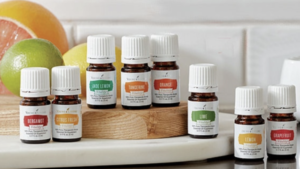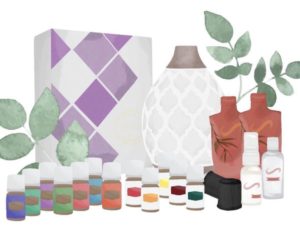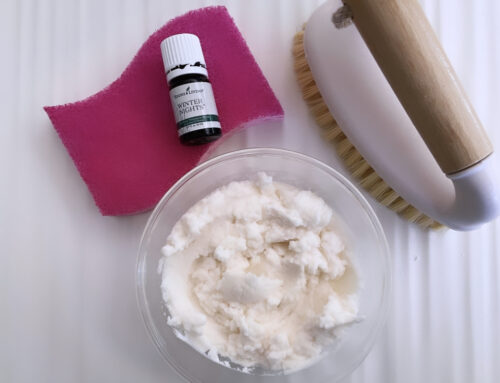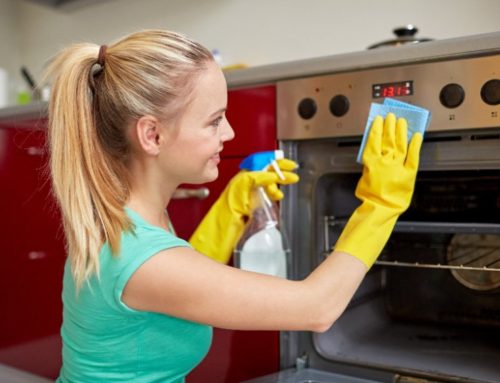How long could keep your family fed using only the food that is currently in your home? Do you know what and how much food is actually in your pantry, refrigerator and freezer right now ? Have you ever thought about the what if scenario in the event food and water were not readily available?
You can easily create a food storage system. Whether you want to store two weeks worth or have enough food to last a year or more, you can create a food preparedness pantry. You can make developing a pantry a creative, fulfilling and rewarding project. Avoid viewing it as a chore as that will defeat your enthusiasm for this very rewarding and productive practice.
Feel free to personalize the following ideas to meet your needs and plan storage for the amount of time that feels right for you.

Start with a blank monthly calendar. Plan a month worth of dinners that you and your family enjoy. Write out weekly shopping lists for the ingredients needed. You can also do this for breakfast and lunch menus or list 10 favorite breakfast and lunch ideas that can be rotated. Include the food ingredients and equipment you need for the meals in your shopping list.
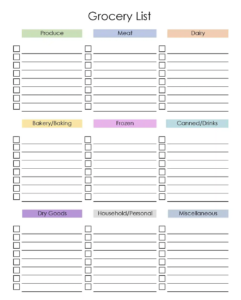
Next plan a location for your pantry. Food should be stored in a cool, dry place. Attics, garages and damp basements are not ideal. Dry, cool basements are fine. Food must be protected from bugs and rodents. If kitchen cabinet and pantry space is limited, can you find or create a high shelf in an existing closet? What about decluttering a linen or coat closet to create a few empty shelves? You can purchase an inexpensive cabinet, bookcase or shelving unit to use. I had a few inexpensive cabinets installed in my (dry/dehumidifier in use) basement. Is it possible to purchase an extra refrigerator or freezer to meet your needs? Creating your pantry can be a work in progress. I like to view it as a hobby that I work on over time. Remember to start with planning menus, shopping lists and space for storage.

Shop at your own pace. Perhaps your budget will allow you to purchase 1-5 extra items each shopping trip. That is fine. Prepping is not hoarding. We are gradually building up a security supply within our own budget. Use your own judgement. This project is fluid and personal.
When you shop, look for the best buy dates while in the store. Purchase items with the furthest date out that is available. When you bring food home, mark the best buy date clearly on the package so you don’t have to squint or get a magnifying glass to find it. Each time you add new food to your shelves, refrigerator or freezer, put the new items to the back and rotate the existing food forward.
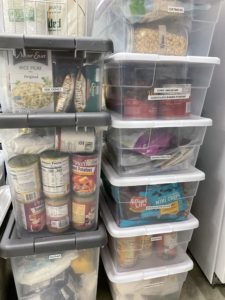
You may want to store some packaged food in plastic bins or air tight containers. A label maker will be your best friend. Masking tape and sharpies are helpful too. Clear bins will allow you to see the contents but do allow light in. Other helpful tools include mason jars and other glass jars, air tight containers, a vacuum sealer with storage bags, freezer paper and for those who are going full in, mylar bags, 10 gallon containers and a food dehydrator.
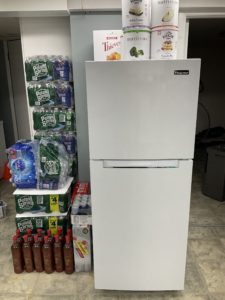
Remember to store water. It is very important to have a large supply of water for each member of your family and pets. I am not a fan of bottled water especially in the soft plastic individual bottles but when it comes to emergencies, you will be glad you have it. Whether you have a water dispenser or not, 5 gallon hard plastic jugs are a good way to store a large amount of water. Having a non-electric water filter such as a Berkey or Life Straw is a good idea.
As with bottled water, I was never a fan of canned food but now I store it. Look for BPA free cans. Canned food has a multi-year shelf life. You may want to pick up soups, stews, beans, canned meat and fish, vegetables, fruit, sauces etc. These foods can be eaten even if you do not have a source of heat in an emergency.
Purchase flour and other baking supplies. I like to put flour and grains in my freezer for 10 days to kill any possible bugs that could later grow in package. I then let any moisture evaporate at room temperature, vacuum seal, date and re-freeze the flour. I also keep a working supply refrigerated in air tight containers. Sugar should not be stored in an airtight container as it will become hard like a rock. I store sugar in glass jars. Brown sugar, however, stores very well and stays soft when sealed in a plastic bag and vacuum sealed. Honey is an excellent sweetener to have on hand and lasts forever. Also consider maple syrup, molasses and agave syrup. Salt, pink Himalayan salt, coarse salt and other varieties are all important to have in stock. I freeze yeast and keep all other baking supplies in a strong tight lid plastic bin.
Whenever possible, especially for long term storage, I prefer to put food in a glass or hard plastic container in place of the cardboard boxes that were sitting in warehouses and on store shelves.
Other grains to consider storing are oatmeal, popcorn, corn meal, quinoa, rice, minute rice and barley. “Just add water” baking mixes also come in handy. Label and watch the expiration dates. Pasta often has a long term best buy date and is a good staple to have in. Cassava flour and cassava flour products are gluten free and add variety to meals.
Have a supply of canned, powered, boxed and non-dairy milk. You can freeze ice cube trays of milk, buttermilk and other speciality milk which will melt easily when you need a small amount. You can also vacuum seal and freeze many cheeses except the most soft such as cottage cheese and cream cheese.
Snacks, favorite foods and beverages help keep your family members’ spirits up. Remember to have coffee, chocolate and all your other favorite comfort foods available.
Eggs can be purchased dried, in a substitute version for baking (not real eggs.) or frozen. To freeze, completely mix together each egg and freeze in a silicone muffin pan. Then you can transfer the frozen individual eggs to a plastic bag and keep in the freezer.
Oils, fats and nuts do not have a long shelf life, yet you do need to have them in stock. You may freeze or refrigerate nuts and refrigerate oils. Some oils will solidify in cold temperatures and will need to be brought back to room temperature before using. Butter may be frozen. Always wrap frozen food and make it as airtight as possible.
Remember to have condiments, sauces, salad dressings and other seasonings that make meals tasty and varied.
Freeze dried food is available in large canisters with shelf lives of 10-20+ years. You can purchase freeze dried cheese, fruits, vegetables, eggs, pancake mix, baking mix and more.
Keeping a printed inventory, especially for foods you may not easily see such as those in a chest freezer is very helpful.
The above ideas are not all inclusive but they are a great start to providing food insurance for your family. Although this article was focused on food, remember to store health and beauty aids, medical supplies and paper goods too.
Did you know:
There is a simple plan to follow in creating a preparedness pantry: Buy foods that you know how to use, that you are willing to eat, prepare them, rotate them and replace them.
Here is an excellent resource for in depth information: A Guide To Food Storage For Emergencies
Have a plan in the event you lose power. Keep refrigerators and freezers closed as much as possible. A generator is invaluable in these situations.
It is important to plan for your pets too. Have food and water stored for them too.
In addition to food, I also have a preparedness essential oil supply. I use essential oils for health and well being, cooking, cleaning and feeling calm and comfortable. There are many blogs on this website about essential oils. If you are interested in learning more and purchasing pure essential oils, check out Young Living Essential Oils
